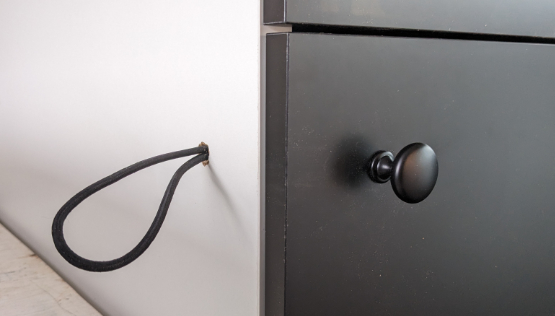The original cabinet I built from scratch ten years ago functioned just fine, but there were some funky bits and some obvious flaws. I tried to fix those things as part of my upgrade, but I ended up making things worse. Sigh.
So rather than build a replacement, I explored pre-made cabinets, hoping to find something that would fit in the former cabinet’s space. And, surprise, Ikea had what I needed. I’d have to modify it to clear the fuel filler bump, but that would have been the case with any cabinet. (What, kitchens don’t have weird sticking out thingies?)
I had to pick up the kit at Ikea’s Albuquerque warehouse. There were seven or eight packages, which made carrying them much easier.
The world is filled with jokes about assembling Ikea stuff. I’ve never had problems before. The trick this time was doing a large, awkward assembly single handed.
The drawers were easy. Screw a couple of tabs to the drawer face, then snap the rest together. And the door hinges clicked into place. No problem. (I thought.)
In order to measure the cutout for the fuel filler, I had to partially assemble the 24 x 24 x 30 box, then get it into and out of the van without damaging it. It’s cumbersome, heavy and slippery.
In the meantime, we had the estate sale, selling off all of Lou’s tools. No more saws. But our neighbor friend Pat has an even better shop and she let me use it. I notched the base, back and side then built a box to close it in. Although Pat’s power tools are top notch, she doesn’t have many clamps. So I had to wait for one joint to dry before I could do the next. But it worked out.
Then the van was in the shop for the new engine and I couldn’t do measurements and test fits.
The top for the cabinet is separate and I decided I wanted to use butcher block. Lowe’s in Las Cruces had them in four-foot lengths an inch-and-a half thick—and about 5,000 pounds.
“Hey Pat, Lowe’s wouldn’t cut the butcher block to size. They said it was too thick. Any chance your table saw can handle this slab?”
“I don’t know. Let’s try.” It worked and now Pat has the unneeded chunk of butcher block.
Then I had to decide how to finish the wood. If I wanted to use the butcher block for actual butchering I treat it with the proper waxy oil stuff. But I just need water resistance, so I went with some tinted polyurethane—after a lot of sanding.
The original plywood cabinet was made with plywood on a poplar frame. But melamine-covered medium density fiberboard is more brittle, and there was a chance the vibrations of driving—particularly on dirt roads—would cause damage. So in addition to Ikea’s fasteners, I glued the panels together, used more screws, ran a bead of super glue along all the seams, and added glued and screwed poplar reinforcements to the joints. It’s very rigid now.
Also, the original cabinet had been secured by a bolt through the van floor plus a couple more bolts attaching it to the end or the bed. But this time (partly because there was no one handy to hold one end of the bolt while I crawled under the van to tighten it) I attached it to the bulkhead.
Once the box was in place I could mount the butcher block and install the drawers and door. No problem with the butcher block. Just some marking of holes and drilling them, then using some lag bolts to secure it to Ikea’s brackets. But, oops, there was a problem with the drawers. There was a large gap between the drawer face and the butcher block. I thought I had screwed the slides into the wrong holes, so I unscrewed them and moved them up. But then the drawer was too high. I finally realized I had installed the faces upside down. So I returned the slides to their original position and… How the hell do I get the faces off the drawers? They snapped in, but how do I unsnap it? After about an hour of poking around in various holes (worried that I’d need to buy two more drawers) I finally found the secret combination! Whew!
So now it’s all done, except I need to mount the knobs, adjust the drawer and door gaps, and notch the shelves to clear my custom corner bracing. One more trip to Pat’s shop. Good thing it’s only a half mile away.












